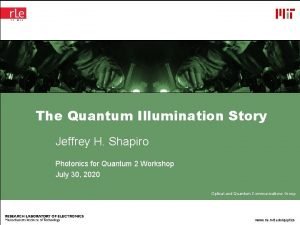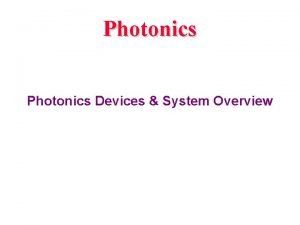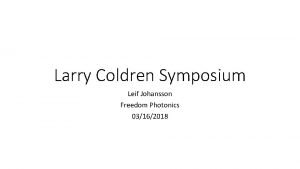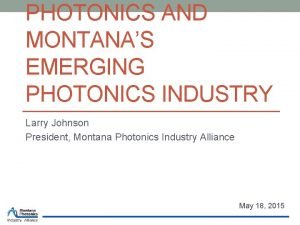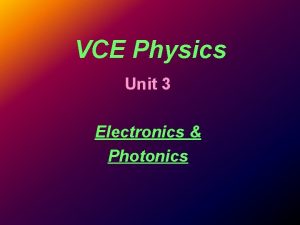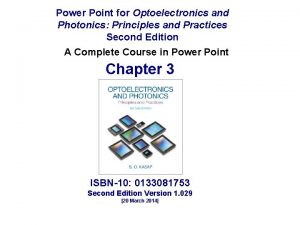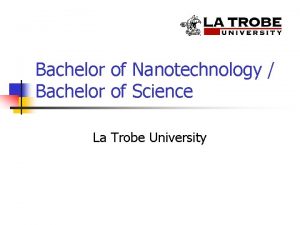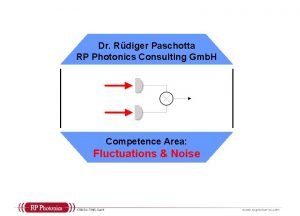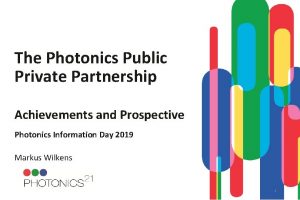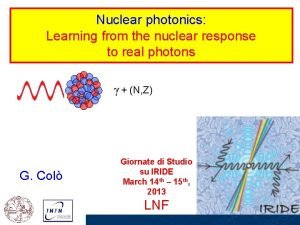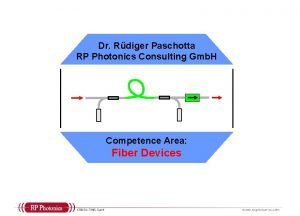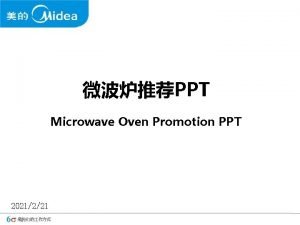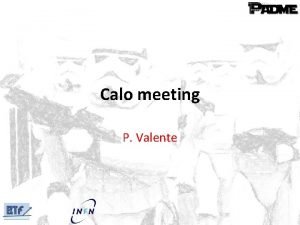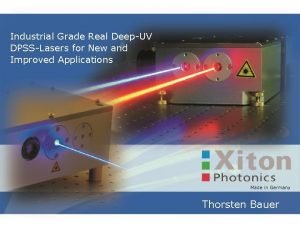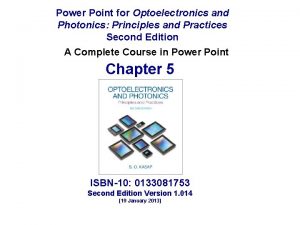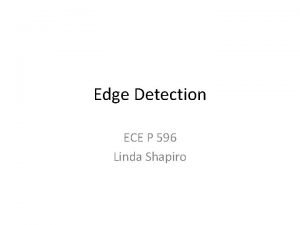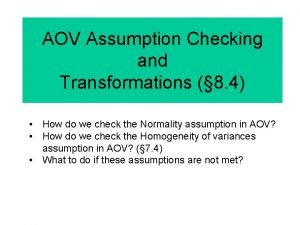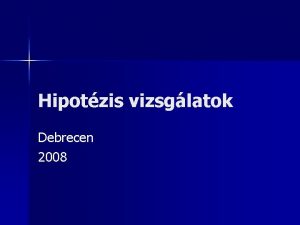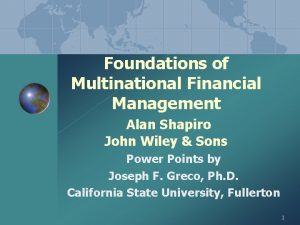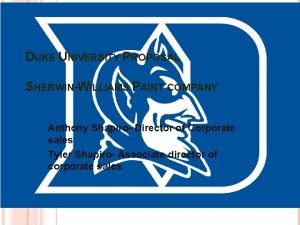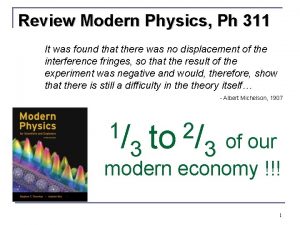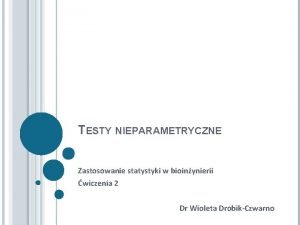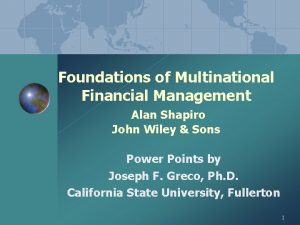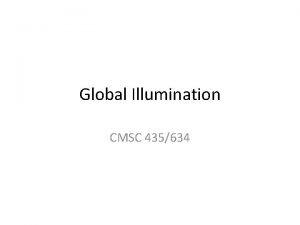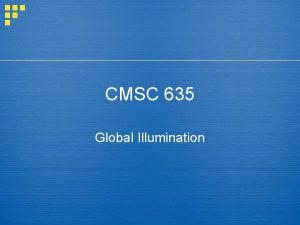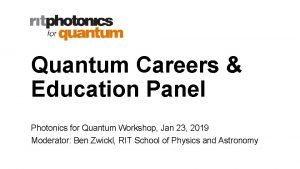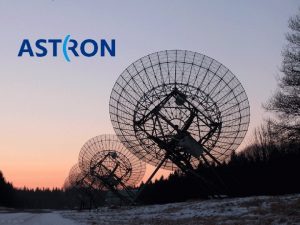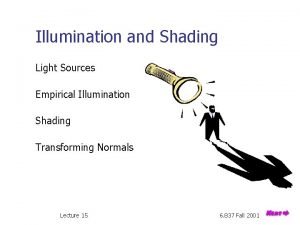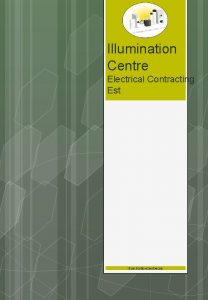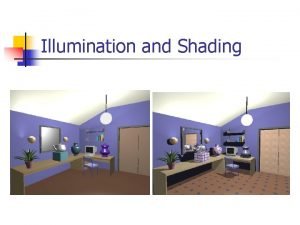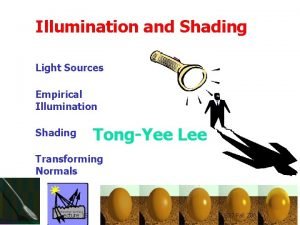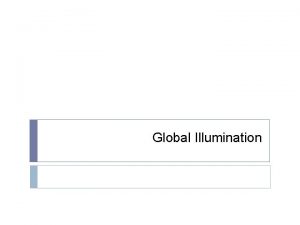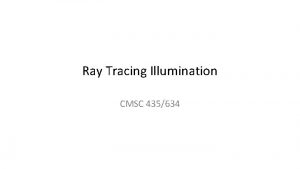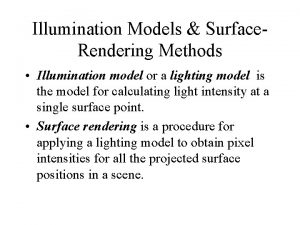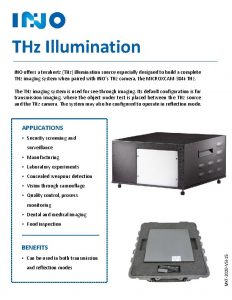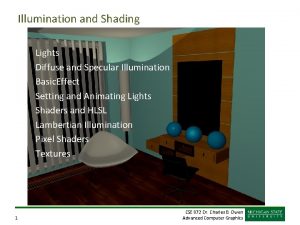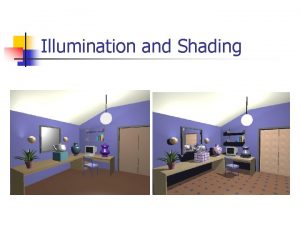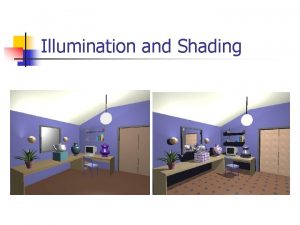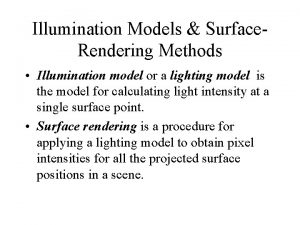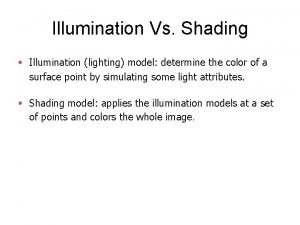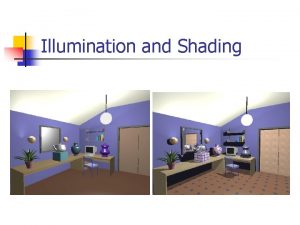The Quantum Illumination Story Jeffrey H Shapiro Photonics






























- Slides: 30

The Quantum Illumination Story Jeffrey H. Shapiro Photonics for Quantum 2 Workshop July 30, 2020 Optical and Quantum Communications Group www. rle. mit. edu/qoptics

Stealth Aircraft… www. rle. mit. edu/qoptics

Stealth Aircraft… and its Existential Threat m u t n ! a r u a Q ad R www. rle. mit. edu/qoptics

Wikipedia knows about Quantum Radar and I’m partly responsible… …but not for the hype about stealth aircraft www. rle. mit. edu/qoptics

You. Tube has Quantum Radar Videos www. rle. mit. edu/qoptics

The Intelligence Community wants Quantum Radar www. rle. mit. edu/qoptics

But is there Fire under the Quantum Radar Smoke? The quantum illumination story will answer that question www. rle. mit. edu/qoptics

The Quantum Illumination Story § Prologue and preliminaries § Lloyd’s quantum illumination and its downfall § Tan et al. ’s quantum illumination § Quantum illumination receivers and experiments § Microwave quantum illumination § The end (? ) of the quantum illumination story § Quantum illumination’s spinoffs § Your final exam § Acknowledgments and further reading www. rle. mit. edu/qoptics

The Quantum Illumination Story: Abridged § Prologue and preliminaries § Lloyd’s quantum illumination and its downfall § Tan et al. ’s quantum illumination § Quantum illumination receivers and experiments § Microwave quantum illumination § The end (? ) of the quantum illumination story § Quantum illumination’s spinoffs § Your final exam § Acknowledgments and further reading www. rle. mit. edu/qoptics

Prologue: Classical versus Quantum Radars § Semiclassical photodetection theory § light is a classical (possibly stochastic) electromagnetic wave § photodetection’s fundamental noise is shot noise § Quantum photodetection theory § light is quantum mechanical § photodetection is a quantum measurement § Definition: classical state § semiclassical and quantum photodetection give same predictions § laser light, LED light, sunlight… are classical states § Classical radar § measurement statistics correctly obtained semiclassically § laser (coherent-state) radars are classical radars § Quantum radar § measurement statistics must be obtained quantum mechanically § single-photon and entangled-state radars are quantum radars www. rle. mit. edu/qoptics

Tan et al. ’s Bosonic-Channel CS Radar § Coherent-state target detection ? coherent-state signal: thermal background: Chernoff bound: Tan, et al. , Phys. Rev. Lett. 101, 253601 (2008) www. rle. mit. edu/qoptics

Tan et al. ’s Bosonic-Channel QI Radar § Coherent-state target detection ? thermal-state signal: thermal background: Chernoff bound: Tan, et al. , Phys. Rev. Lett. 101, 253601 (2008) www. rle. mit. edu/qoptics

Tan et al. ’s Error-Probability Bounds § Upper bounds (UBs) are Chernoff bounds: exponentially tight § Lower bound (LB) is Bhattacharyya bound: known to be loose § All bounds are for optimum quantum receivers § No QI receiver known in 2008 provided any advantage over CS § Homodyne reception for CS radar achieves CS Chernoff bound § The CS lower bound applies to all classical radars of the same NS value § QI’s upper bound < CS’s lower bound QI beats all classical radars Tan, et al. , Phys. Rev. Lett. 101, 253601 (2008) www. rle. mit. edu/qoptics

The Why and How Questions for Tan et al. ’s QI § Why does entanglement provide an advantage? § signal-idler entanglement is in the phase-sensitive cross correlation… § but… loss (�� << 1) and noise (NB >> 1) kill that entanglement § even so, classical resources cannot produce as strong a signature § How can we realize the predicted quantum advantage? § the usual signal-idler coincidence counting doesn’t work… § high-brightness background implies every idler detection yields a coincidence § coherent (heterodyne/homodyne) detection doesn’t work… § error-probability Chernoff bounds obey § …we need a quantum phase-sensitive cross-correlation measurement www. rle. mit. edu/qoptics

Optical Parametric Amplifier (OPA) Receiver for QI § Low-gain OPA generates § Photon counter measures § Error probability: Guha and Erkmen, Phys. Rev. A 80, 052310 (2009) § Quantum-illumination (QI) setup 20% SNR improvement despite 14 d. B of loss and noise 75 d. B stronger than the returned signal § SNR gain with QI QI CI Zhang, et al. , Phys. Rev. Lett. 114, 110506 (2015) www. rle. mit. edu/qoptics

Microwave Quantum Illumination § QI needs low-brightness signal, high-brightness background, and high time-bandwidth product § High-brightness background not present at optical wavelengths… but it is at microwavelengths… so let’s do microwave QI § Target-detection configuration § Electro-optomechanical converter Barzanjeh, et al. , Phys. Rev. Lett. 114, 080503 (2015) www. rle. mit. edu/qoptics

Microwave Quantum Illumination… and its Hype www. rle. mit. edu/qoptics

And the Hype Goes on… www. rle. mit. edu/qoptics

A Digression… Correlated Noise Radars § A correlated noise radar… § § § prepares correlated signal and reference beams detects the reference beam immediately interrogates the region of interest with the signal beam detects the return from the region of interest correlates the detected reference and return to sense target presence § A quantum-correlated noise (QCN) radar… § employs entangled signal and reference beams § A classically-correlated noise (CCN) radar… § employs classical-state signal and reference beams § SPDC transmitter with heterodyne receiver is a QCN radar… § but amplifying the transmitter beam will make it a CCN radar www. rle. mit. edu/qoptics

Microwave QI Experiments… and Their Limitations § Luong et al. , IEEE Trans. Aerosp. Electron. Sys. 56, 2041 (2020) § Luong et al. ’s is a classically-correlated noise radar… § transmits the amplified SPDC-produced signal § heterodyne detects the SPDC-produced idler and returned signal § Luong et al. compare to a suboptimum classically-correlated noise radar… § heterodyne detects the classically-correlated idler and returned signal § Their QTMS radar outperforms neither a CS-Hom radar nor an optimized classically-correlated noise radar www. rle. mit. edu/qoptics

Microwave QI Experiments… and Their Limitations § Barzanjeh et al. , Sci. Adv. 6, eabb 0451 (2020) § Barzanjeh et al. ’s is a classically-correlated noise radar… § transmits the amplified SPDC-produced signal § heterodyne detects the SPDC-produced idler and returned signal § Barzanjeh et al. compare to a suboptimum non-SPDC classicallycorrelated noise radar and an optically-amplified CS-transmitter radar… § Their SPDC radar outperforms neither a true CS-Hom radar nor an optimized classically-correlated noise radar www. rle. mit. edu/qoptics

Receiver Operating Characteristics § No surprises here… § Miss probability (PM) versus false-alarm probability (PF) § CS-Het is coherent-state radar with heterodyne reception § CCN is classically-correlated noise radar: perfectly correlated low-brightness signal and high-brightness idler with heterodyne reception § QCN is quantum-correlated noise radar: SPDC source with heterodyne reception § CS-Hom is coherent-state radar with homodyne reception § QI-OPA is quantum illumination with OPA receiver § CS-Hom is best classical radar § Heterodyne receiver offers no QI advantage Shapiro, IEEE Aerosp. Electron. Sys. Mag. 35, 8 (2020) www. rle. mit. edu/qoptics

The End (? ) of the QI Story § Optical QI not advantageous… § no performance gain because of low-brightness background § Microwave QI not advantageous. . . § minimal performance gain because of limited time-bandwidth product § Optimum QI suffers from single resolution-bin interrogation. . . § 6 d. B gain for single azimuth-elevation-range-Doppler-polarization bin § 3 d. B gain for two azimuth-elevation-range-Doppler-polarization bins § no gain for four azimuth-elevation-range-Doppler-polarization bins § Idler storage is a big problem. . . § currently best choice is optical idler stored in an optical fiber § OPA receiver offers no performance gain for range beyond 11. 25 km § Optimum receiver offers no gain for range beyond 22. 5 km § Remember QI’s meta-lesson: entanglement can be beneficial for an entanglement-breaking bosonic channel www. rle. mit. edu/qoptics

Further Reading: The Rest of the QI Story IEEE Aerosp. Electron. Sys. Mag. 35, 8 (2020), available online at IEEE Xplore www. rle. mit. edu/qoptics

Quantum Illumination’s Important Spinoffs § Quantum key distribution (QKD) — if pushed to high enough secret -key rates (SKRs) — will enable one-time-pad (OTP) encryption, i. e. , information-theoretic-secure transmission § But, BB 84’s SKRs are Mbps class at metropolitan-area distances, so QKD is used to rekey classical cryptosystems § Floodlight QKD 1, an intellectual grandchild of QI target detection, may enable Gbps SKRs over metropolitan-area distances, so OTP encryption could become possible Zhuang, et al. , Phys. Rev. A 95, 012332 (2017); Zhang, et al. , Quantum Sci. Technol. 3, 025007 (2018) § But, suppose an adversary has somehow acquired your cryptosystem’s decryption key… § Quantum low probability of intercept 2 (QLPI) to the rescue… § an intellectual great-grandchild of QI target detection, QLPI enables Alice and Bob to defeat the key-disclosure threat Shapiro, et al. , J. Opt. Soc. Am. B 36, B 41 (2019) www. rle. mit. edu/qoptics

Your Final Exam… s i e h t k l a l i m W e m c u ? r t k u n r o a s qu wo r a d ra www. rle. mit. edu/qoptics

Your Final Exam… and its short answer N ! o www. rle. mit. edu/qoptics

Full Credit… requires some supporting evidence § The IC wants 1012 entangled microwave photon-pairs/s § pairs/s = pairs/mode x modes/s = NS x W § REMEMBER: QI relies on low brightness, NS << 1, for its advantage § Edge case A § NS = 1, conservative upper limit on low-brightness operation § 1012 pairs/s → W = 1 THz, unattainable in the microwave region § Edge case B § W = 50 GHz, conservative upper limit on bandwidth at 60 GHz carrier § 1012 pairs/s → NS = 20, definitely not low-brightness operation § And we haven’t even mentioned other major problems… § broadband quantum memory, OPA or FF-SFG receiver, … www. rle. mit. edu/qoptics

Acknowledgments § My QI collaborators… § Shabir Barzanjeh, Baris Erkmen, Saikat Guha, Seth Lloyd, Lorenzo Maccone, Sara Mouradian, Stefano Pirandola, Si-Hui Tan, David Vitali, Christian Weedbrook, Franco Wong, Zheshen Zhang, and Quntao Zhuang § Financial support for my QI research came from… § W. M. Keck Foundation, DARPA, Office of Naval Research, Army Research Office, Air Force Office of Scientific Research, and MITRE Corporation www. rle. mit. edu/qoptics

Epilogue… Wikipedia has been Updated www. rle. mit. edu/qoptics
 The quantum illumination story
The quantum illumination story Classical physics
Classical physics Quantum physics vs mechanics
Quantum physics vs mechanics What is optoelectronics
What is optoelectronics Leif johansson religion
Leif johansson religion Montana photonics industry alliance
Montana photonics industry alliance Current divider formula
Current divider formula Energy band diagram of n type semiconductor
Energy band diagram of n type semiconductor Advantages and disadvantages of nanotechnology
Advantages and disadvantages of nanotechnology Paschotta
Paschotta Photonics
Photonics Nuclear photonics
Nuclear photonics Rp fiber power
Rp fiber power Microwave photonics ppt
Microwave photonics ppt Hzc photonics
Hzc photonics Xiton photonics
Xiton photonics Optoelectronics and photonics chapter 3 solution
Optoelectronics and photonics chapter 3 solution Edge shapiro
Edge shapiro Shapiro
Shapiro Shapiro wilk teszt
Shapiro wilk teszt Roy d. shapiro
Roy d. shapiro Jo shapiro peer support
Jo shapiro peer support Transverse conductivity
Transverse conductivity Woodlane medical centre ruislip
Woodlane medical centre ruislip Multinational financial management definition
Multinational financial management definition Ben shapiro muscles
Ben shapiro muscles David shapiro natick
David shapiro natick Duke blue paint
Duke blue paint Shapiro experiment
Shapiro experiment Irena horek
Irena horek Multinational financial management shapiro
Multinational financial management shapiro
